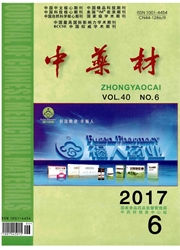

 中文摘要:
中文摘要:
目的:比较不同种源丹参根多糖含量,考察丹参根多糖含量随生长时间的变化规律.方法:采用热水浸提法提取丹参多糖,苯酚-硫酸法测定多糖含量.结果:丹参根(包括木质部和韧皮部)多糖含量随时间呈动态变化,不同种源丹参根多糖含量随时间的变化规律不尽相同,且同一时期不同种源丹参根多糖含量存在明显差异.不同生长时期,多糖在丹参根木质部和韧皮部的分布情况不同.不同种源丹参均结实期时多糖含量最低;采收期时以北京种源丹参多糖含量最高,江苏种源次之,河南种源最低.结论:本实验为高多糖丹参种源的筛选及丹参多糖的开发利用提供理论依据.
 英文摘要:
英文摘要:
Objective:To detect the content of polysaccharides in the root of Salvia miltiorrhiza collected from different prove- nances, and to discover the dynamic change rules of polysaccharides at various growing stages. Methods : Polysaccharides were extracted by hot water extraction method, and the content of polysaccharides was measured by phenol-sulfuric acid. Results :The content of poly- saecharides changed at different growing stages. The variation trend of different provenances were different, and the polysaccharides con- tent of different provenances were different at the same growing stage. At different growing periods, the distribution of polysaccharides in the xylem and cortex of roots were different. The content of polysacehrides in the root was minimum at maturity. At harvest time, the con- tent of polysaccharides in the root was the highest in Beijing, the second was in Jiangsu, and the lowest was in Henan. Conclusion : The experiment provides theoretical basis for the selection of Salvia mihiorrhiza with the highest content of polysaccharides and the develop- ment and utilization of the polysaccharides.
 同期刊论文项目
同期刊论文项目
 同项目期刊论文
同项目期刊论文
 期刊信息
期刊信息
